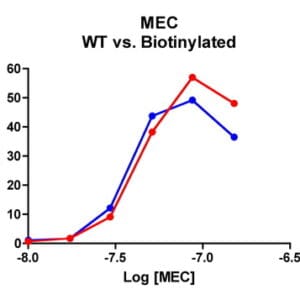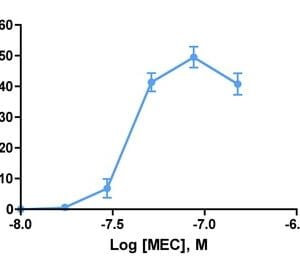| Weight | 1 lbs |
|---|---|
| Dimensions | 9 × 5 × 2 in |
| accession | P13500 |
| express system | E.coli |
| product tag | biotin at C-terminal |
| purity | > 97% by SDS PAGE |
| molecular weight | Predicted Molecular Mass: 11.085 kDa Extinction Coefficient: 14,180 M-1 cm-1 Actual Molecular Mass: 11.085 kDa by ESI MS |
| available size | 10 µg, 100 µg, 2 µg, 50 µg |
| endotoxin | <0.01 EU per 1μg of the protein by the LAL method |
Biotinylated Human CCL2 (MCP-1) 6003
Price range: $134.00 through $3,368.00
Summary
- Expression: E.coli
- Amino Acid Range: 24-99
Biotinylated Human CCL2 (MCP-1) 6003
| protein |
|---|
| Database link: human P13500 |
| Size and concentration 2, 10, 50, 100µg and lyophilized |
| Form Lyophilized |
| Storage Instructions Avoid repeated freeze-thaw cycles: • 12 months from date of receipt, -20 to -70 °C as supplied. • 1 month, 2 to 8 °C under sterile conditions after reconstitution. • 3 months, -20 to -70 °C under sterile conditions after reconstitution |
| Storage buffer ​Reconstitution: Spin sample prior to reconstitution. Recommended concentration of 100µg/mL in sterile water. Shipping: Room Temp |
| Purity > 97% by SDS PAGE and HPLC |
| target relevance |
|---|
| Monocyte chemoattractant protein-1 (MCP-1/CCL2) is produced by many cell types at sites of inflammation. It regulates chemotaxis and transendothielial migration of monocytes, as well as memory T cells and natural killer cells by interacting with their membrane surface receptor CCR2. MCP-1 has also been implicated in a number of disease states, such as rheumatoid arthritis, atherosclerosis, autoimmune diseases, tumor progression, and HIV infection. This cytokine displays activity for monocytes and basophils but not for neutrophils or eosinophils. It binds to chemokine receptors CCR2 and CCR4. Biotinylated CCL2 is made using the enzymatic method, which has several advantages over chemical biotinylation methods. The attachment of biotin at a specific lysine residue within the C-terminal avi tag sequence is nearly 100% complete, and leads to a modified chemokine with functionalities comparable to those of the unmodified CCL2 in migration assay. Combining with avidin analogues conjugated to various fluorescent labels, biotinylated CCL2 is useful in studies on receptor identification, distribution, chemokine binding, and other cellular assays. They serve as great tools in visualization and quantification, and replace the needs for radioactively labeled chemokines. |
| Protein names C-C motif chemokine 2 (HC11) (Monocyte chemoattractant protein 1) (Monocyte chemotactic and activating factor) (MCAF) (Monocyte chemotactic protein 1) (MCP-1) (Monocyte secretory protein JE) (Small-inducible cytokine A2) |
| Gene names CCL2,CCL2 MCP1 SCYA2 |
| Protein family Intercrine beta (chemokine CC) family |
| Mass 11025Da |
| Function FUNCTION: Acts as a ligand for C-C chemokine receptor CCR2 (PubMed:10529171, PubMed:10587439, PubMed:9837883). Signals through binding and activation of CCR2 and induces a strong chemotactic response and mobilization of intracellular calcium ions (PubMed:10587439, PubMed:9837883). Exhibits a chemotactic activity for monocytes and basophils but not neutrophils or eosinophils (PubMed:8195247, PubMed:8627182, PubMed:9792674). May be involved in the recruitment of monocytes into the arterial wall during the disease process of atherosclerosis (PubMed:8107690). {ECO:0000269|PubMed:10529171, ECO:0000269|PubMed:10587439, ECO:0000269|PubMed:8107690, ECO:0000269|PubMed:8195247, ECO:0000269|PubMed:8627182, ECO:0000269|PubMed:9792674, ECO:0000269|PubMed:9837883}. |
| Subellular location SUBCELLULAR LOCATION: Secreted {ECO:0000269|PubMed:23955712, ECO:0000269|PubMed:2513477}. |
| Tissues TISSUE SPECIFICITY: Expressed in the seminal plasma, endometrial fluid and follicular fluid (at protein level) (PubMed:23765988). Expressed in monocytes (PubMed:2513477). {ECO:0000269|PubMed:23765988, ECO:0000269|PubMed:2513477}. |
| Structure SUBUNIT: Monomer or homodimer; in equilibrium (PubMed:15033992, PubMed:8898111, PubMed:8989326, PubMed:9837883). Is tethered on endothelial cells by glycosaminoglycan (GAG) side chains of proteoglycans (PubMed:9792674). Interacts with TNFAIP6 (via Link domain). {ECO:0000269|PubMed:15033992, ECO:0000269|PubMed:27044744, ECO:0000269|PubMed:8898111, ECO:0000269|PubMed:8989326, ECO:0000269|PubMed:9792674, ECO:0000269|PubMed:9837883}. |
| Post-translational modification PTM: Processing at the N-terminus can regulate receptor and target cell selectivity (PubMed:8627182). Deletion of the N-terminal residue converts it from an activator of basophil to an eosinophil chemoattractant (PubMed:8627182). {ECO:0000269|PubMed:8627182}.; PTM: N-Glycosylated. {ECO:0000269|PubMed:2513477}. |
| Target Relevance information above includes information from UniProt accession: P13500 |
| The UniProt Consortium |
Data
| No results found |
Publications
| pmid | title | authors | citation |
|---|---|---|---|
| We haven't added any publications to our database yet. | |||
Protocols
| relevant to this product |
|---|
| Migration assay |
Documents
| # | ||
|---|---|---|
| Please enter your product and batch number here to retrieve product datasheet, SDS, and QC information. | ||
















